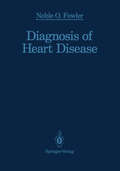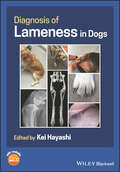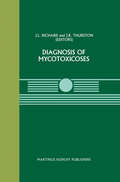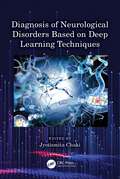- Table View
- List View
Diagnosis of Aging Skin Diseases
by A. M. Kligman Robert A. NormanA book that will be welcome to practising dermatologists everywhere, this fantastically useful new volume presents a visual encyclopedia of geriatric dermatoses that can be used by clinicians on rounds or in a reference environment. It provides a structured illustrated review of the various lesions encountered, which will make this an invaluable reference resource for all physicians dealing with older skin. It also places special emphasis on illnesses originating in other organ systems that are made manifest on the skin and often complicate the diagnostic and therapeutic picture. Robert Norman, of Tampa, Florida, USA, is an experienced geriatric dermatologist and has published several dermatology textbooks.
Diagnosis of Blood and Bone Marrow Disorders
by Sa A. Wang Robert P. HasserjianThis book focuses on hematopoietic and lymphoid neoplasms that initially present as peripheral blood abnormalities, with either cytopenias or elevated peripheral blood counts, as well as non-neoplastic conditions that may raise concern for a hematologic malignancy. The scope of the book includes myelodysplastic syndromes (MDS), myeloproliferative neoplasms (MPN), mixed myelodysplastic/myeloproliferative neoplasms (MDS/MPN), as well as lymphomas and lymphoid leukemias that typically present initially with peripheral blood abnormalities. Within each category, a comprehensive list of differential diagnoses is discussed. For each disease entity, the reader is updated with new molecular genetic data, biomarkers, and recent applications of immunophenotyping, and how to incorporate the new information in disease diagnosis and classifications is illustrated, including the use of diagnostic algorithms where appropriate. The book employs the revised WHO Classification of Hematopoietic Neoplasms for all disease entities. Diagnosis of Blood and Bone Marrow Disorders will serve as a very useful resource for pathologists, pathologists in training, hematologists and medical technologists who are involved in the clinical work-up of patients with bone marrow and blood neoplasms. It will provide a practical and concise yet comprehensive review.
Diagnosis of Cholecystoses: A radiological survey with clinical aspects
by J.H.J. Ruijs S.G.Th. HulstDiagnosis of Cutaneous Lymphoid Infiltrates: A Visual Approach to Differential Diagnosis and Knowledge Gaps
by Antonio SubtilThis volume is the first of its kind to emphasize the visual approach in the diagnosis of cutaneous lymphoid infiltrates. Written and designed in an accessible yet highly detailed format by an expert in the field, this book bridges the knowledge gaps so often found when dealing with skin lymphomas. Complete with more than two hundred high quality images and illustrations, Diagnosis of Cutaneous Lymphoid Infiltrates offers pearls and pitfalls as well as differential diagnoses. Additionally, images are explained and decoded with the use of illustrations and analogies, proving to be an invaluable resource for pathologists, dermatologists, dermatopathologists, hematopathologists, and residents and fellows in these fields.
Diagnosis of Endometrial Biopsies and Curettings: A Practical Approach
by Emanuela F.T. Veras Michael T. Mazur Robert J. Kurman Tricia A. MurdockDerived from the authors' long-running course presented at the International Academy of Pathology, this second edition, now with color illustrations, continues the tradition of its predecessor as being the concise and complete diagnostic guide to the endometrial biopsy. The text is structured so as to present a logical approach to formulating a pathologic diagnosis from the diverse array of tissue received in the surgical pathology laboratory. Color illustrations show typical artifacts and distortion, and explain their impact on diagnostic interpretation. Each chapter includes a section summarizing the features that must be discussed in the final pathology report.
Diagnosis of Endometrial Biopsies and Curettings: A Practical Approach
by Michael Mazur Robert J. KurmanA logical approach to formulating a pathologic diagnosis from the diverse array of tissue received in the surgical pathology laboratory. The authors are both prominent gynaecologic pathologists, and this book is the result of their long-running Short Course presented at the International Academy of Pathology. Illustrations show typical artefacts and distortion and explain their impact on diagnostic interpretation, and each chapter includes a section on "Clinical Queries and Reporting" that summarises the features to be discussed in the final pathology report. Here is a strongly didactic approach to one of the most frequently ordered pathological examinations. You find superb illustrations on virtually every page and fast answers to everyday questions since emphasis is placed on clinically relevant material: commonly encountered specimens, common problems and common diagnostic issues.
Diagnosis of Endometrial Biopsies and Curettings: A Practical Approach
by Michael Mazur Robert J. KurmanDerived from the authors' long-running course presented at the International Academy of Pathology, this second edition, now with color illustrations, continues the tradition of its predecessor as being the concise and complete diagnostic guide to the endometrial biopsy. The text is structured so as to present a logical approach to formulating a pathologic diagnosis from the diverse array of tissue received in the surgical pathology laboratory. Color illustrations show typical artifacts and distortion, and explain their impact on diagnostic interpretation. Each chapter includes a section summarizing the features that must be discussed in the final pathology report.
Diagnosis of Fungal Infections
by Johan Maertens Kieren A. MarrAnalyzing a key cause of infectious morbidity in immunosuppressed and immunocompromised patients, this source spans the most recent strategies to improve and expedite the diagnosis, identification, and treatment of fungal infections. With authoritative contributions from experienced clinicians in the field, this reference tracks developments in ima
Diagnosis of Fungal Infections
by Kieren A. Marr Johan MaertensAnalyzing a key cause of infectious morbidity in immunosuppressed and immunocompromised patients, this source spans the most recent strategies to improve and expedite the diagnosis, identification, and treatment of fungal infections. With authoritative contributions from experienced clinicians in the field, this reference tracks developments in ima
Diagnosis of Heart Disease
by Noble O. FowlerHere is a practical guide giving you systematic strategies for correctly diagnosing heart disease. The emphasis is on the patient's history and the physical examination, the two cornerstones of medical diagnosis. These are correlated with knowledge of the natural history of disease and the physical findings of subsequent examination techniques. The role of current examination technology - both invasive and noninvasive - is discussed. Important advances in the field, including procedures such as echocardiography, transesophageal probe, exercise electrocardiography, nuclear ventriculography and magnetic resonance imaging, are taken into consideration. The book covers all major heart diseases and is liberally illustrated.
Diagnosis of human peroxisomal disorders: A handbook
by Guy T. N.Besley Ruud B. H.Schutgens SylviaBie FrankRoelsPeroxisomal disorders constitute a major research front in clinical genetics, paediatrics and cell biology. Since 1983, the metabolic defect in some 20 different peroxisomal disorders has been described. The best known conditions include Zellweger syndrome, rhizomelic chondrodysplasia punctata and X-linked adrenoleukodystrophy and, in the most recent edition of The Metabolic and Molecular Basis Inherited Disease, edited by Scriver and colleagues, more than 100 pages are now devoted to the subject. Progress in our understanding of these conditions, and their diagnosis, results from the application of a variety of laboratory investigations. These include microscopic studies, analysis of metabolites (very long-chain fatty acids, bile acids, and plasmalogens), enzyme studies (peroxisomal beta-oxidation pathway and dihydroxyacetone phosphate acyltransferase), immunodetection of peroxisomal (membrane) proteins and molecular analysis of mutant DNA. In order to encourage a greater awareness in this field and the diagnostic protocols required, an international course was organised in Gent, Belgium, in May 1994, on the clinical and biochemical diagnosis of peroxisomal disorders. A number of international experts in the field who provided intensive hands-on experience over 3.5 days, have now collected their course work and reviews together in this Handbook. The volume is introduced by Sidney Goldfischer, who in 1973 was the first to recognise the absence of peroxisomes in Zellweger syndrome, but whose observations were not fully appreciated for a further decade. This handbook provides the most comprehensive and detailed account of laboratory methods for the diagnosis of peroxisomal disorders. The methods are clearly presented and well illustrated, and should allow laboratories to introduce these methods into their repertoire. Audience: Paediatricians, neurologists, clinical biochemists, pathologists, genetic counsellors, obstetricians, and GPs interested in the recognition, diagnosis and prenatal prevention of peroxisomal disorders.
Diagnosis of Human Viruses by Polymerase Chain Reaction Technology (Frontiers of Virology #1)
by Yechiel Becker Gholamreza DaraiThe basis for the effective treatment and cure of a patient is the rapid diagnosis of the disease and its causative agent, which is based on the analysis of the clinical symptoms coupled with laboratory tests. Although rapid advance ments have been made in the laboratory diagnosis of virus diseases, the neces sary isolation of the causative virus from the clinical specimens is a relatively long procedure. Viruses which integrate into the cellular DNA (such as human immunodeficiency virus, HIV -1, or hepatitis B virus) are difficult to identify by molecular techniques, while viruses which exist in the clinical material in low concentrations are even more formidable to identify. Recently, the application of the polymerase chain reaction (peR) technique developed by K. D. Mullis and detailed in the study by Saiki et al. (1985) led to a revolution in virus diagnosis. The peR technique was rapidly applied to the diagnosis of viruses in clinical material. Volume 1 of Frontiers of Virology provides new information on the advan tages of the use of the peR for the diagnosis of many human disease-causing viruses, as well as on some problems with its use.
Diagnosis of Lameness in Dogs
by Kei HayashiDiagnosis of Lameness in Dogs Accessible and easy-to-understand step-by-step guide to the diagnosis of lameness in dogs Diagnosis of Lameness in Dogs provides general practice vets with a practical, step-by-step guide to performing the orthopedic diagnostic exam, including basic diagnostic imaging and advanced techniques such as CT, MRI, ultrasound, and arthroscopy, and arriving at a correct diagnosis. Treatment options are briefly summarized with the focus of the book being on diagnostics – because general practitioners will generally refer lameness cases. This book therefore provides guidance on possible causes of lameness and when to refer, and perhaps more critically, when not to refer. Overall, the text enables general practice veterinarians and veterinary students to develop confidence in accurately diagnosing causes of lameness. More than 600 color images depicting the procedures are included throughout the text. A companion website provides video clips of specific lameness conditions to aid in reader comprehension and information retention. Written by well-known orthopedic surgeons working in the area of lameness, Diagnosis of Lameness in Dogs also includes information on: General examinations, providing a systematic approach to the examination ensures that multiple problems are not missed Immediate steps to provide urgent care to severely traumatized dogs with hemorrhaging wounds and unstable/open fractures Systemic conditions, neurological disorders, and oncologic diseases that need to be ruled out before arriving at a diagnosis of the problem Specific conditions and diagnostic procedures for the thoracic limb, including bone disease, carpal/distal joints, the elbow joint, and the shoulder joint Specific conditions and diagnostic procedures for the pelvic limb, including bone disease, tarsal/distal joints, the stifle joint, and the hipar joint The first book to cover lameness diagnosis in detail, Diagnosis of Lameness in Dogs is a highly useful resource for veterinarians and students interested in improving their orthopedic diagnostic skills through gaining a foundation of relevant knowledge and an understanding of how to apply this knowledge in a field setting.
Diagnosis of Lameness in Dogs
by Kei HayashiDiagnosis of Lameness in Dogs Accessible and easy-to-understand step-by-step guide to the diagnosis of lameness in dogs Diagnosis of Lameness in Dogs provides general practice vets with a practical, step-by-step guide to performing the orthopedic diagnostic exam, including basic diagnostic imaging and advanced techniques such as CT, MRI, ultrasound, and arthroscopy, and arriving at a correct diagnosis. Treatment options are briefly summarized with the focus of the book being on diagnostics – because general practitioners will generally refer lameness cases. This book therefore provides guidance on possible causes of lameness and when to refer, and perhaps more critically, when not to refer. Overall, the text enables general practice veterinarians and veterinary students to develop confidence in accurately diagnosing causes of lameness. More than 600 color images depicting the procedures are included throughout the text. A companion website provides video clips of specific lameness conditions to aid in reader comprehension and information retention. Written by well-known orthopedic surgeons working in the area of lameness, Diagnosis of Lameness in Dogs also includes information on: General examinations, providing a systematic approach to the examination ensures that multiple problems are not missed Immediate steps to provide urgent care to severely traumatized dogs with hemorrhaging wounds and unstable/open fractures Systemic conditions, neurological disorders, and oncologic diseases that need to be ruled out before arriving at a diagnosis of the problem Specific conditions and diagnostic procedures for the thoracic limb, including bone disease, carpal/distal joints, the elbow joint, and the shoulder joint Specific conditions and diagnostic procedures for the pelvic limb, including bone disease, tarsal/distal joints, the stifle joint, and the hipar joint The first book to cover lameness diagnosis in detail, Diagnosis of Lameness in Dogs is a highly useful resource for veterinarians and students interested in improving their orthopedic diagnostic skills through gaining a foundation of relevant knowledge and an understanding of how to apply this knowledge in a field setting.
Diagnosis of Liver Disease
by Etsuko Hashimoto Paul Y. Kwo Arief A. Suriawinata Wilson M. S. Tsui Masaki IwaiThis book guides practitioners in the assessment of patients with a liver problem. The emphasis is on the role of macro- and microscopic pathology in elucidating pathogenesis as well as identifying confounding features of image findings that may lead to a more elaborate differential diagnosis. If appropriate, the role of light and electron microscopic examination, along with the role of specific stains and molecular techniques, is illustrated. In addition, the concept of each liver disease is summarized briefly and its up-to-data is provided, and unresolved problems in diagnosis, treatment, and pathogenesis are clearly described.The approach in this book is a practical one with a focus on the evaluation of illustrative cases, simultaneously demonstrating cross-sectional images (ultrasonography, computed tomography, magnetic resonance imaging, and angiography), pathological findings, and peritoneoscopic images. The diagnosis and therapy are summed up in helpful tables, and association of clinical manifestations with image analysis and pathological findings is shown to be important in differential diagnosis and treatment. With the authors comprising internationally renowned experts, this book will serve as a useful source of information for medical students, physicians, internists, hepatologists, gastroenterologists, radiologists, and pathologists worldwide.
The Diagnosis of Lymphoproliferative Diseases
by Kevin Gatter Georges Delsol Roger Warnke Francesco PezzellaThis highly illustrated, diagnostic guidebook provides a single comprehensive source of essential information to enable non-specialists to diagnose lymph node and related diseases with confidence. The text is didactic and practical, covering reactive as well as malignant conditions. Diagnosis of Lymphoproliferative Diseases approaches the disorders based on the WHO classification and is edited by members of the WHO panel for the classification of lymphomas. This second edition contains over 1000 high quality, digitised colour images and tables of essential criteria for each diagnosis. New features include: Full discussion of immunostaining, the core of modern diagnosis Variant forms and technical issues This authoritative guide is an essential reference for haematologists, haematopathologists, general pathologists, diagnostic histopathologists and oncologists.
The Diagnosis of Lymphoproliferative Diseases
by Kevin Gatter Georges Delsol Roger Warnke Francesco PezzellaThis highly illustrated, diagnostic guidebook provides a single comprehensive source of essential information to enable non-specialists to diagnose lymph node and related diseases with confidence. The text is didactic and practical, covering reactive as well as malignant conditions. Diagnosis of Lymphoproliferative Diseases approaches the disorders based on the WHO classification and is edited by members of the WHO panel for the classification of lymphomas. This second edition contains over 1000 high quality, digitised colour images and tables of essential criteria for each diagnosis. New features include: Full discussion of immunostaining, the core of modern diagnosis Variant forms and technical issues This authoritative guide is an essential reference for haematologists, haematopathologists, general pathologists, diagnostic histopathologists and oncologists.
Diagnosis of Musculoskeletal Tumors and Tumor-like Conditions: Clinical, Radiological and Histological Correlations - The Rizzoli Case Archive
by Piero Picci Marco Manfrini Marco Gambarotti Daniel Vanel Davide Maria Donati Alberto Righi Angelo Paolo Dei TosThis book, now in a second revised edition, casts light on the often complex diagnosis of musculoskeletal tumors and tumor-like conditions by drawing on the experience of the Rizzoli Orthopedic Institute during more than 100 years of treatment and research in the field. The different entities are described from a multidisciplinary perspective, highlighting clinical, radiological, and histological correlations. Particular emphasis is placed on differential diagnosis, which often needs to take into account nontumoral conditions. The recent identification of further significant biological and genetic features, and the impact of these discoveries on the classification of round cell tumors, vascular lesions, and spindle/pleomorphic entities in bone, is also extensively discussed. The Rizzoli case archive dates back to September 1900 and contains the original material relating to more than 29,000 bone lesions and 11,000 soft tissue lesions. It is a fabulously rich resource, and this book will be invaluable for pathologists, radiologists, and clinicians at all levels of experience.
Diagnosis of Mycobacterium
by Amit Singh Divakar SharmaThis book covers all the aspects related to the laboratory diagnosis of Mycobacterium. Laboratory diagnosis includes microscopic to advance molecular diagnosis. Moreover, it deals with the methods used to detect antimycobacterial susceptibility tests and drug resistance. Chapters cover most potential methods and techniques from traditional to advanced future diagnostics for identifying tuberculosis, NTM, and latent TB infections. Also discussed the challenges and opportunities in the diagnostic science of infectious disease. This book offers assistance to students, postgraduate medical students, researchers, medical practitioners, postdoctoral fellows, microbiologists, nurses, and public health officers working in tuberculosis control programs to understand various modalities for diagnosis and drug-resistance tuberculosis.
Diagnosis of Mycotoxicoses (Current Topics in Veterinary Medicine #33)
by J. R. Thurston J. L. RichardCurrent problems associated with the mycotoxicoses include the recognition of an animal disease as being a mycotoxicosis and confirmation of diagnosis of the mycotoxicosis by satisfactory laboratory methods. By gathering a vast amount of scientific literature, diagnosticians can provide themselves with suitable informa tion for making such a diagnosis. However, the increased number of reported intoxications caused by fungi, the wide range in diversity of disease conditions and the chemical compounds causing the mycotoxicoses, and the ever-changing and rapid developments in the technology of mycotoxin analysis has made the gathering and assimilation of sufficient information by the diagnostician an insurmountable task. This is the reason for development of the symposium and the publication of this book; the first time that the subject of diagnosis of mycotoxicoses has been assembled in a single publication and as a compilation of topic papers by experts in this subject area. The UJNR panel on toxic microorganisms is interested in all aspects of intox ications by microorganisms as evidenced by its annual joint meetings in either the United States or Japan and its involvement in sponsoring numerous symposia and several publications in this broad scientific area. The overall mission of the National Animal Disease Center includes research efforts in the improvement or establishment of diagnostic methods for animal diseases. The UJNR panel and the NADC provided the funds and encouragement for the development of a symposium on the diagnosis of mycotoxicoses in the United States and . Tapan.
Diagnosis of Neurological Disorders Based on Deep Learning Techniques
by Jyotismita ChakiThis book is based on deep learning approaches used for the diagnosis of neurological disorders, including basics of deep learning algorithms using diagrams, data tables, and practical examples, for diagnosis of neurodegenerative and neurodevelopmental disorders. It includes application of feed-forward neural networks, deep generative models, convolutional neural networks, graph convolutional networks, and recurrent neural networks in the field of diagnosis of neurological disorders. Along with this, data preprocessing including scaling, correction, trimming, and normalization is also included. Offers a detailed description of the deep learning approaches used for the diagnosis of neurological disorders. Demonstrates concepts of deep learning algorithms using diagrams, data tables, and examples for the diagnosis of neurodegenerative, neurodevelopmental, and psychiatric disorders. Helps build, train, and deploy different types of deep architectures for diagnosis. Explores data preprocessing techniques involved in diagnosis. Includes real-time case studies and examples. This book is aimed at graduate students and researchers in biomedical imaging and machine learning.
Diagnosis of Neurological Disorders Based on Deep Learning Techniques
This book is based on deep learning approaches used for the diagnosis of neurological disorders, including basics of deep learning algorithms using diagrams, data tables, and practical examples, for diagnosis of neurodegenerative and neurodevelopmental disorders. It includes application of feed-forward neural networks, deep generative models, convolutional neural networks, graph convolutional networks, and recurrent neural networks in the field of diagnosis of neurological disorders. Along with this, data preprocessing including scaling, correction, trimming, and normalization is also included. Offers a detailed description of the deep learning approaches used for the diagnosis of neurological disorders. Demonstrates concepts of deep learning algorithms using diagrams, data tables, and examples for the diagnosis of neurodegenerative, neurodevelopmental, and psychiatric disorders. Helps build, train, and deploy different types of deep architectures for diagnosis. Explores data preprocessing techniques involved in diagnosis. Includes real-time case studies and examples. This book is aimed at graduate students and researchers in biomedical imaging and machine learning.
Diagnosis of Non-accidental Injury: Illustrated Clinical Cases (Illustrated Clinical Cases Ser.)
by Vincent J. Palusci Dena Nazer Patricia BrennanRecognition and diagnosis of child abuse and neglect creates an important foundation for the protection of children. Physicians and other healthcare providers have a fundamental role in this process, and need to be confident that they can identify correctly the signs and symptoms that provide clues to non-accidental injuries resulting from child ma
Diagnosis of Non-accidental Injury: Illustrated Clinical Cases (Illustrated Clinical Cases Ser.)
by Vincent J. Palusci Dena Nazer Patricia BrennanRecognition and diagnosis of child abuse and neglect creates an important foundation for the protection of children. Physicians and other healthcare providers have a fundamental role in this process, and need to be confident that they can identify correctly the signs and symptoms that provide clues to non-accidental injuries resulting from child ma
Diagnosis of Onychomycosis and Other Nail Disorders: A Pictorial Atlas
by C. Ralph DanielDIAGNOSIS OF ONYCHOMYCOSIS AND OTHER NAIL DISORDERS will serve as a diagnostic guide for dermatologists, primary care physicians and residents in terms of identifying both the symptoms of various nail diseases and their etiologies. Written by a highly respected and well -known dermatologist, this volume employs the use of 4-color photographs and limited text to assist the audience in distinguishing the various types of nail diseases including: inflammatory nail disorders, traumatic nail disorders, and local infections. Due to the increasing frequency of nail infections, and the difficulties often encountered in treating them, this practical manual will become a valuable tool for practitioners.



















